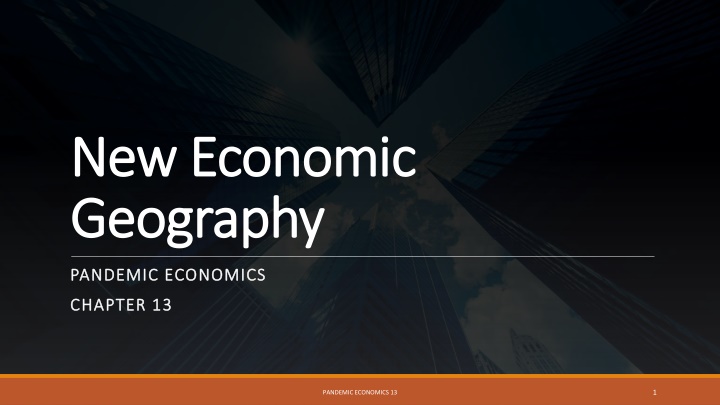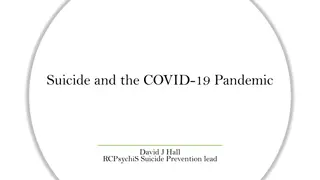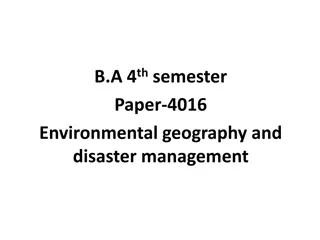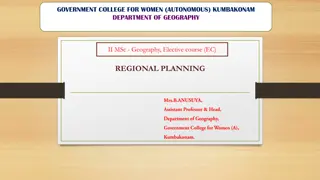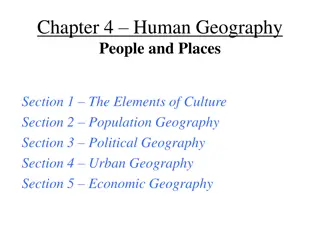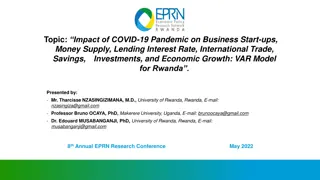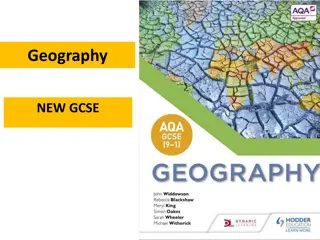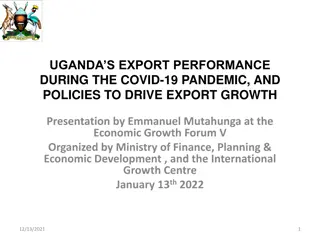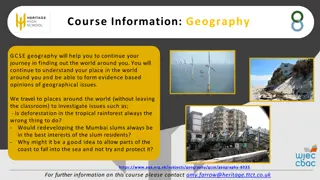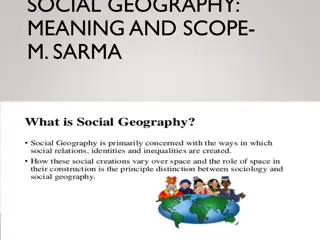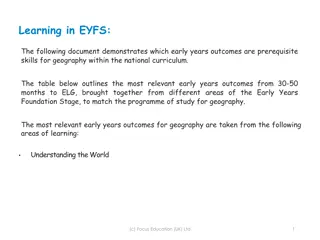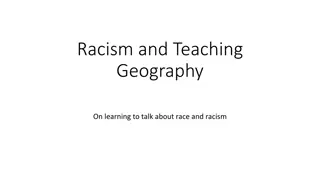New Economic Geography and Pandemic Effects
Economic geography plays a crucial role in analyzing the impact of pandemics on different regions. Discover how pandemics spread unevenly across geographic areas, affecting economic activities and urban-rural dynamics. Explore the framework of new economic geography and its application in understanding pandemic outcomes and responses.
Download Presentation

Please find below an Image/Link to download the presentation.
The content on the website is provided AS IS for your information and personal use only. It may not be sold, licensed, or shared on other websites without obtaining consent from the author.If you encounter any issues during the download, it is possible that the publisher has removed the file from their server.
You are allowed to download the files provided on this website for personal or commercial use, subject to the condition that they are used lawfully. All files are the property of their respective owners.
The content on the website is provided AS IS for your information and personal use only. It may not be sold, licensed, or shared on other websites without obtaining consent from the author.
E N D
Presentation Transcript
New Economic New Economic Geography Geography PANDEMIC ECONOMICS PANDEMIC ECONOMICS CHAPTER 13 CHAPTER 13 1 PANDEMIC ECONOMICS 13
1. Economic Geography and Pandemic Outcomes 2. New Economic Geography: A Framework for Economists Topics Topics 3. Themes of Economic Geography 4. Applications of Economic Geography 5. Spatial Diffusion and Network-Drive Contagion 6. Responses to Pandemic Outcomes 2 PANDEMIC ECONOMICS 13
Learning Objectives Learning Objectives After reading this chapter, you will be able to: After reading this chapter, you will be able to: LO1 Explain that pandemics spread through geographic space in uneven patterns. LO2 Identify the components of the model of new economic geography, focusing on the importance of transportation costs. LO3 Discuss themes of economic geography, including globalization, uneven development, and place. LO4 Analyze applications such as urbanization and pandemic shocks, spatial equilibrium and pandemic costs, and smart cities and pandemic resilience. LO5 Contrast factor-driven outcomes with network-driven contagion in the context of spatial diffusion. LO6 Identify appropriate responses to pandemic outcomes for urban and rural areas. 3 PANDEMIC ECONOMICS 10
The coronavirus pandemic first infected people in urban areas and then spread to rural sectors. 1. Economic 1. Economic Geography Geography and Pandemic and Pandemic Outcomes Outcomes In the United States, for example, the Covid-19 disease started to spread in urban areas in early 2020. By October 2020, confirmed cases in rural areas were higher. 4 PANDEMIC ECONOMICS 13
5 PANDEMIC ECONOMICS 13
Economic Geography Economic Geography The field of economic geographyaddresses where economic activity occurs and why. This focus is important for understanding both the structure of economies and the effects of pandemics. Pandemics spread unevenly across geographic space, leading to regionally differentiated outcomes. 6 PANDEMIC ECONOMICS 13
2. New 2. New Economic Economic Geography: A Geography: A Framework Framework Known as new economic geography after the publication of Paul Krugman s seminal (1991) article: Spatial economics addresses why production and economic activity concentrate in geographic space. A circular pattern develops. for for Economists Economists 7 PANDEMIC ECONOMICS 13
The Circular Pattern of Economic Activity The Circular Pattern of Economic Activity Businesses locate where workers live, and workers want to live where businesses operate. Two forces: An agglomeration force promotes geographical concentration (centripetal force) A dispersion force pushes economic activity away from a geographic center (centrifugal force) New economic geography addresses the nature of these forces. 8 PANDEMIC ECONOMICS 13
Increasing Returns and Economic Geography Increasing Returns and Economic Geography Krugman (1991) develops a model that demonstrates how an economy may become differentiated between a production core and an agricultural periphery. In the model, two regions exist: Manufacturing Agriculture 9 PANDEMIC ECONOMICS 13
The Two Regions The Two Regions Each region has the same number of farmers who exhibit immobility and identical productivity. But manufacturing activity and the manufacturing labor supply are mobile. On the supply side, manufacturers minimize transportation costs, pursue economies of scale, and locate in regions with higher demand for their products. On the demand side, the consumption of output depends on the location of production. 10 PANDEMIC ECONOMICS 13
Location of Manufacturing Location of Manufacturing Why do manufacturing companies concentrate in geographic space, leaving other regions relatively undeveloped? The core-periphery pattern depends on the: share of manufacturing in national income economies of scale transportation costs When manufacturing firms choose a location for production, they hire workers who live and consume in that region. This pattern creates local forward and backward linkages that perpetuate the economic activity. 11 PANDEMIC ECONOMICS 13
Model Characteristics Model Characteristics ECONOMIES OF SCALE GEOGRAPHICAL CONCENTRATION Manufacturing is characterized by a modest use of land and increasing returns to scale. A large local market and economies of scale create sites that are conducive for production, support the production of intermediate inputs, and decrease costs for downstream producers. Agriculture is characterized by an intensive use of land and constant returns to scale. 12 PANDEMIC ECONOMICS 13
Process of Economic Development Process of Economic Development Economic development entails a process of economic growth in interlinked spatial structures, which includes production, consumption, and commuter networks. Although the manufacturing sector in many developed economies represents a small percentage of total production, economic concentration suggests that: Economic geography displays structures of regionalization Structures of regionalization match descriptions of urban cores and agricultural peripheries 13 PANDEMIC ECONOMICS 13
Agglomerated and Dispersed Equilibria Agglomerated and Dispersed Equilibria Both agglomerated and dispersed equilibria may exist, depending on the value of a key parameter: transportation cost. The model begins with two symmetric regions and two industries: Imperfectly competitive and mobile manufacturing Perfectly competitive and immobile agriculture 14 PANDEMIC ECONOMICS 13
The Models Simplifying Assumptions The Model s Simplifying Assumptions Farmers that produce agricultural goods are sector-specific, face zero transportation costs, and receive a uniform wage. Workers in manufacturing pursue higher real wages in either region. Manufacturing firms enter and exit the industry in response to profits and losses. With these assumptions, it is possible to analyze when diversification (manufacturing dispersed between regions) or agglomeration (core-periphery) occurs. The pull of the immobile farmers generates the centrifugal force but the linkages in manufacturing generate the centripetal force. 15 PANDEMIC ECONOMICS 13
The Role of Transportation Costs ( The Role of Transportation Costs (T T) ) A high level of T encourages diversification between regions. As T declines from a high level, it reaches the sustain point (TS): Diversification between regions ceases to serve as an equilibrium. When transportation costs decline, producers evaluate opportunities in the other region. As T decreases further, transportation costs reach the break point (TB), at which the diversified equilibrium breaks down. As transportation costs decrease below TB, the conditions are sufficient for core-periphery organization (agglomeration). 16 PANDEMIC ECONOMICS 13
Summary of Threshold Conditions Summary of Threshold Conditions TS Sustain point: diversification between regions ceases to serve as an equilibrium TB Break point: the diversified equilibrium breaks down TS > TB A decrease in transportation cost increases agglomeration and the movement to the core-periphery configuration. If transportation costs are below TS, the model will not restore the diversified equilibrium. 17 PANDEMIC ECONOMICS 13
Model Configuration Depends on Model Configuration Depends on Transportation Costs Transportation Costs T > TS: unique equilibrium with the highest level of diversification, workers equally divided between regions, and the absence of a core-periphery configuration T = TS: two potential equilibria with manufacturing concentrating in either region TB < T < TS: three potential equilibria with manufacturing spread between the regions and two agglomerated equilibria, one in each region T = TB: two potential equilibria with partial concentration of manufacturing in one region or a full concentration of manufacturing in one region T < TB: unique equilibrium with the lowest level of diversification, agglomeration in one region, and a stable core-periphery framework 18 PANDEMIC ECONOMICS 13
19 PANDEMIC ECONOMICS 13
Bifurcation Model Demonstrates a Bifurcation Model Demonstrates a Dispersion of Economic Activity Dispersion of Economic Activity Start at point a with the highest transportation cost and an even division of manufacturing between region one and region two A decrease in T to point b unleashes the movement of manufacturing. Between points b and c, economic forces shift manufacturing work between the two regions, although a possibility remains that the workers are equally distributed. At point c, the economy begins a cumulative process in which a concentration of manufacturing in one region creates momentum for more manufacturing in that region. Below point c, the economy establishes a core-periphery framework. 20 PANDEMIC ECONOMICS 13
Globalization: The widening and deepening interconnections among countries, companies, and individuals through all forms of exchange. 3. Themes of 3. Themes of Economic Economic Geography Geography Uneven development: Some regions or countries are more prosperous and economically influential than others. Place: How areas become interconnected in wider economic processes, and the consequences for their identity, existence, and distinctiveness. 21 PANDEMIC ECONOMICS 13
The defining focus of economic geography is the desire to address the concentration of economic activity and/or population, such as: Industry clusters Characteristics of cities Manufacturing and farm belts These forms exist because of spatial economics. 4. 4. Applications Applications of Economic of Economic Geography Geography 22 PANDEMIC ECONOMICS 13
Urbanization and Pandemic Shocks Urbanization and Pandemic Shocks Urbanization refers to the movement from rural to urban areas and the methods in which society adapts to the change. Because urbanization exists as a process, it may reverse. A pandemic initially spreads disease through areas with higher population density: Reducing employment options Increasing the relative price of agricultural output to the core Providing incentive for workers to move to the periphery 23 PANDEMIC ECONOMICS 13
Spatial Equilibrium and Pandemic Costs Spatial Equilibrium and Pandemic Costs The economic approach to cities applies the concept of spatial equilibriumto laborers and businesses. Locational choices focus on the understanding of the motivations to live in specific areas. All else equal, relatively higher pandemic costs in an urban area encourage the flow of workers and businesses to rural areas. 24 PANDEMIC ECONOMICS 13
Smart Cities and Pandemic Resilience Smart Cities and Pandemic Resilience To attract residents and improve the quality of life, smart citiesapply technological advances, sensors, and other methods of observation to gather data for a smart city matrix. A pandemic impacts all indicators. Taken together, the changes lead to a mixed outcome. 25 PANDEMIC ECONOMICS 13
Smart Economy Smart Smart Governance Smart Smart Pandemic Resilience Smart Energy Smart Society Environment Infrastructure Transportation Energy efficiency Government effectiveness Infrastructure invesment Educational attainment Transport efficiency GDP per capita Air quality Response rate R&D Goverment digitalization Technology integration Clean energy Water quality Green space Poverty rate Death toll expenditure Unemployment rate Waste Public Smart device penetration Traffic congestion Economic support Energy storage Gender equity management participation Ecosystem turnover Water resources Healthcare index Infrastructure capacity Gini coefficient Energy cost Corruption rate Accessibility 26 PANDEMIC ECONOMICS 13
Spatial diffusiondemonstrates that pandemics spread in global networks, regional sectors, and local areas. But important sites, called hotspots or hubs, defined as areas of origin for the spread of disease, may exist in urban or rural areas. 5. Spatial 5. Spatial Diffusion and Diffusion and Network Network- - Driven Driven Contagion Contagion Two approaches describe the process, factor-driven outcomes and network- driven contagion. 27 PANDEMIC ECONOMICS 13
Factor Factor- -Driven Outcomes Driven Outcomes Demographic, economic, environmental, and social factors contribute to pandemic outcomes, including health expenditure, air quality, intervention policies, global interconnectedness, and demographic trends. Some cities conduct aggressive testing procedures during initial infection waves but others do not. Higher rates of testing identify transmission rates, providing information for interventions, business closures, and healthcare resources. 28 PANDEMIC ECONOMICS 13
Network Network- -Driven Contagion Driven Contagion The spread of disease is complex, dynamic, and driven by networks. The heterogeneity and multiscale characteristics of the process complicate the understanding of network effects, timelines, and treatments. However, even though a disease may spread on a global scale, spatiotemporal patternsthat occur in a wide range of natural phenomena may be reduced to wave patterns that spread across geographical space. 29 PANDEMIC ECONOMICS 13
Impact on Rural Areas Impact on Rural Areas During a pandemic, rural areas may seem immune. When infections and deaths rise in cities, health officials may report fewer rural cases. But that false sense of security becomes a problem when rural areas become susceptible to the spread of disease. Contagion may spread through towns and villages where testing and tracing resources are scarce and families cannot afford to quarantine. 30 PANDEMIC ECONOMICS 13
Impact on Urban Areas Impact on Urban Areas The process of urbanization intensifies problems in cities, including congestion, pollution, and traffic, but also presents opportunities for economic growth and economies of scale. Higher levels of population density make cities more vulnerable to the spread of disease, at least when infections are accelerating. But cities also have the ability to manage the crisis through economic shutdowns. 31 PANDEMIC ECONOMICS 13
Social Vulnerability Social Vulnerability The emerging field of vulnerability sciencehelps to conceptualize circumstances that put people at risk from hazardous events and the conditions that inhibit appropriate responses Vulnerability science establishes strategies for risk, hazard, and disaster reduction. The field integrates the constructs of hazard, mitigation, resilience, risk, and susceptibility into one framework. It establishes an interactive approach among economic, healthcare, natural, and social systems. 32 PANDEMIC ECONOMICS 13
Anticipating Future Shocks Anticipating Future Shocks Imbedded in vulnerability science is the necessity of anticipating future shocks, evaluating uncertainty, and modelling potential outcomes. What makes particular regions vulnerable? How do the processes of globalization, industrialization, and urbanization impact the susceptibility of regions? To answer these questions, the estimation of risk, forecasting of potential losses, establishment of interactive susceptible-infection-recovered models, creation of comparative indicators, visualization of potential responses, and creation of decision-making frameworks serve as important components. 33 PANDEMIC ECONOMICS 13
By understanding how specific areas are susceptible to the spread of disease, communities may formulate appropriate responses. In urban areas, susceptibility is a function of population density, requiring aggressive intervention measures such as quarantines, social distancing, and sheltering-in-place. 6. Responses 6. Responses to Pandemic to Pandemic Outcomes Outcomes In rural areas with lower population densities, these interventions may not be appropriate. Instead, rural interventions should focus on specific members of the population, including the elderly, individuals with poor health, those living in nursing homes, and workers in meatpacking plants and other large facilities. 34 PANDEMIC ECONOMICS 13
Policy Implementation Policy Implementation A pandemic and its outcomes should encourage the implementation of policies that strengthen the institutions of both rural and urban regions. The identification of high-risk areas helps public sectors anticipate and prepare for future shocks. But the management of responses to pandemic outcomes such as lower levels of employment and higher levels of mortality should adapt to changing circumstances, rely on successful experiences, and recognize capacity limits. 35 PANDEMIC ECONOMICS 13
